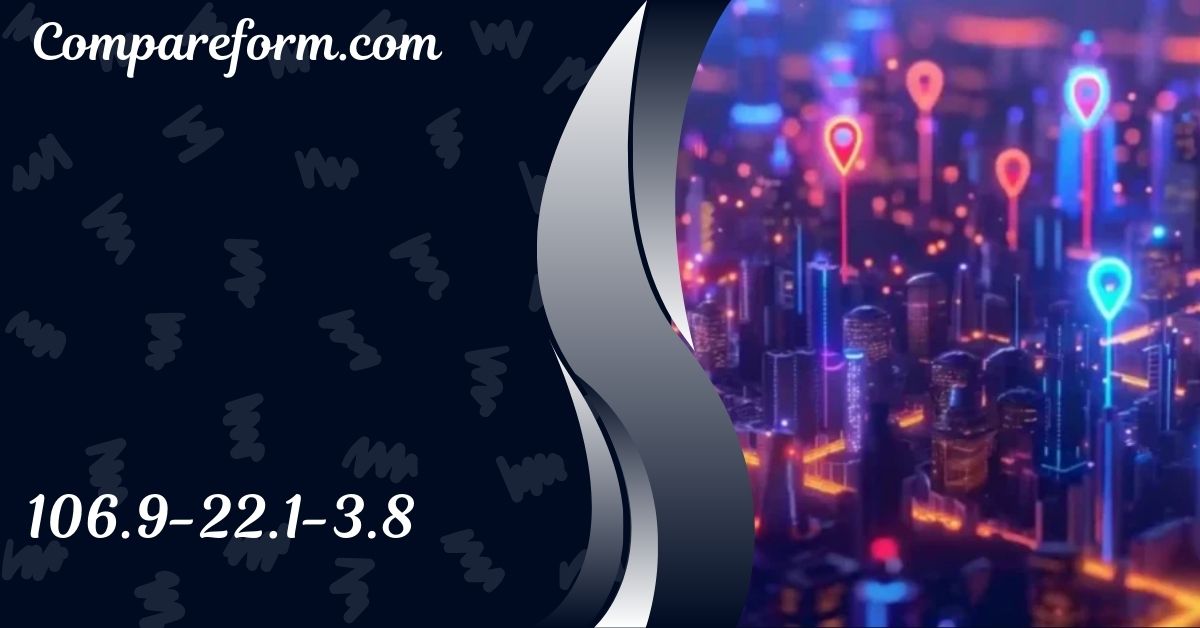Understanding the Analytical Framework of 106.9-22.1-3.8
In today’s rapidly evolving world, analytics play a crucial role in how industries operate and make decisions. One of the powerful analytical frameworks that have emerged is represented by the numbers 106.9-22.1-3.8.
This framework, while seemingly abstract, holds significant relevance across various sectors, including finance, environmental science, and medical research.
This article aims to provide a comprehensive overview of 106.9-22.1-3.8, discussing its origins, applications, and implications in an easily digestible format for readers across the United States.
What Does 106.9-22.1-3.8 Represent?
At first glance, the numbers 106.9-22.1-3.8 may seem arbitrary, but they encapsulate a sophisticated analytical framework used to interpret data trends and derive insights.
This framework combines various statistical techniques to analyze datasets and improve decision-making processes. By breaking down this framework, we can appreciate its significance in multiple sectors.
Historical Context: The Birth of Statistical Modeling
The foundation of the 106.9-22.1-3.8 framework can be traced back to the early development of statistical modeling. Statistical modeling emerged as a tool for interpreting data, allowing professionals to make predictions based on historical trends.
This evolution was pivotal for industries reliant on data for strategic planning and forecasting. In the late 19th and early 20th centuries, statisticians like Karl Pearson and Ronald Fisher laid the groundwork for modern statistical techniques.
Their work led to the development of various models that form the backbone of the 106.9-22.1-3.8 framework. Understanding this historical context helps us appreciate the significance of the framework today.
Components Breakdown: Understanding the Numbers
To fully grasp the implications of 106.9-22.1-3.8, we must delve into each component and its unique contribution to the framework.
106.9: A Statistical Insight
The first component, 106.9, typically represents a central statistical figure, such as a mean or median in a given dataset. This figure serves as a baseline for analysis. For instance, in financial forecasting, this number could represent an average return on investment, helping analysts determine future profitability.
In a broader context, 106.9 can signify a benchmark in various fields. For instance, in environmental science, it could denote an average pollutant level over a specific period, serving as a reference point for assessing changes in environmental conditions.
22.1: The Analytical Perspective
The second component, 22.1, is often associated with the variance or standard deviation of the dataset. Variance measures the degree of spread in the data points, offering insights into the reliability and consistency of the findings. A lower value indicates that the data points are closely clustered around the mean, while a higher value suggests a wider spread.
In finance, 22.1 could indicate the volatility of an investment, helping investors gauge risk. In medical research, it may reflect the variability in patient responses to a particular treatment, essential for understanding the effectiveness of healthcare interventions.
3.8: Applications in Real Life
Finally, 3.8 typically represents a coefficient or ratio derived from the analysis, such as a correlation coefficient that indicates the strength and direction of a relationship between variables. For example, in financial analysis, this might represent the correlation between market trends and economic indicators.
In medical research, 3.8 could indicate the odds ratio in a clinical trial, helping researchers understand the effectiveness of a treatment relative to a control group. This component is crucial for making informed decisions based on data insights.
Industry Applications of 106.9-22.1-3.8
The framework of 106.9-22.1-3.8 finds applications across various industries. Here, we explore its significance in finance, environmental science, and medical research.
Finance
In the finance sector, the 106.9-22.1-3.8 framework is instrumental in risk assessment and investment analysis. Financial analysts utilize this framework to evaluate the expected returns of investments against their associated risks. By analyzing historical data represented by 106.9 (average returns) and 22.1 (variance), analysts can develop strategies to maximize profits while minimizing risks.
Moreover, the correlation represented by 3.8 can help analysts understand the relationship between market factors, enabling them to make informed investment decisions.
Environmental Science
In environmental science, 106.9-22.1-3.8 plays a critical role in assessing environmental changes and the impact of human activities. For instance, 106.9 might represent the average concentration of a pollutant in a specific region, while 22.1 can indicate fluctuations in pollutant levels over time.
Researchers use this framework to identify trends, assess compliance with environmental regulations, and develop strategies for pollution control. The relationship represented by 3.8 can also help in understanding how various environmental factors influence one another.
Medical Research
In the field of medical research, 106.9-22.1-3.8 is essential for evaluating treatment efficacy and patient outcomes. The average outcome represented by 106.9 allows researchers to gauge the effectiveness of a treatment across a population, while 22.1 provides insight into the variability in treatment responses.
The coefficient or ratio of 3.8 can indicate the strength of the relationship between a treatment and patient recovery rates. This information is invaluable for making evidence-based decisions in clinical practice and policy development.
Interpreting 106.9-22.1-3.8: A Deep Dive
Understanding the implications of 106.9-22.1-3.8 requires a nuanced interpretation of the numbers in context. Let’s explore some practical scenarios that illustrate how this framework can be applied.
Case Study 1: Financial Investment Decision
Imagine a financial analyst evaluating a potential investment in a tech startup. The average return (106.9) on similar investments in the sector is promising, but the high variance (22.1) indicates significant volatility.
The correlation coefficient (3.8) reveals a strong relationship between market trends and investment returns, suggesting that timing the market could be crucial for maximizing profits. By analyzing these components together, the analyst can make an informed decision about whether to invest in the startup.
Case Study 2: Environmental Impact Assessment
Consider an environmental scientist studying air quality in an urban area. The average pollutant level (106.9) indicates that the city is above recommended health standards. The variance (22.1) shows that certain neighborhoods experience significantly higher pollution levels.
The correlation of 3.8 between traffic volume and pollutant levels indicates a strong relationship, guiding policymakers to implement strategies like reducing traffic in high-pollution areas to improve air quality.
Case Study 3: Clinical Trial Evaluation
In a clinical trial for a new medication, researchers observe an average improvement in symptoms (106.9) among patients. However, the variance (22.1) suggests that some patients respond exceptionally well, while others do not respond at all.
The odds ratio (3.8) indicates a strong relationship between the treatment and symptom improvement, leading researchers to consider personalized treatment options based on patient profiles.
Future Implications of 106.9-22.1-3.8
The framework of 106.9-22.1-3.8 is not static; it evolves as new methodologies and technologies emerge. As data collection becomes more sophisticated and accessible, the potential applications of this analytical framework will only expand.
Trends to Watch
- Big Data Integration: As industries increasingly rely on big data, the 106.9-22.1-3.8 framework can be enhanced to analyze larger datasets, leading to more accurate predictions and insights.
- Machine Learning: The integration of machine learning algorithms can refine the analysis of 106.9-22.1-3.8, allowing for real-time decision-making based on dynamic data inputs.
- Cross-Disciplinary Applications: The versatility of this framework means it can be applied across various fields, leading to innovative solutions in areas like public health, urban planning, and disaster management.
FAQs
What is the significance of the numbers in 106.9-22.1-3.8?
The numbers represent key statistical components: 106.9 typically indicates a central tendency, 22.1 shows variability, and 3.8 denotes a relationship between variables.
How can 106.9-22.1-3.8 be applied in daily decision-making?
This framework can help individuals make informed decisions based on averages, variability, and relationships between different factors, whether in finance, health, or environmental contexts.
Is the 106.9-22.1-3.8 framework relevant only in specific industries?
No, the 106.9-22.1-3.8 framework can be applied across various sectors, including finance, environmental science, and medical research, making it versatile for different analytical needs.
How can I learn more about statistical modeling?
Many online courses and resources are available, ranging from beginner to advanced levels, covering statistical modeling techniques and their applications in various fields.
Conclusion
The analytical framework of 106.9-22.1-3.8 serves as a powerful tool for understanding data trends and making informed decisions across multiple industries. By breaking down its components and exploring its applications, we can appreciate its significance in today’s data-driven world. As industries continue to evolve, so too will the applications of this framework, paving the way for innovative solutions to complex problems.






